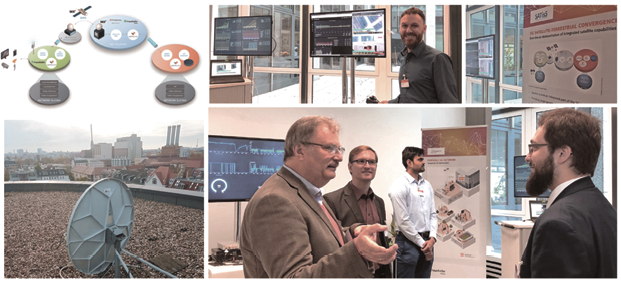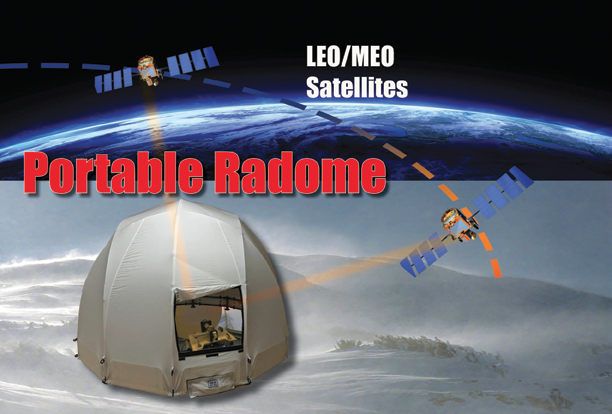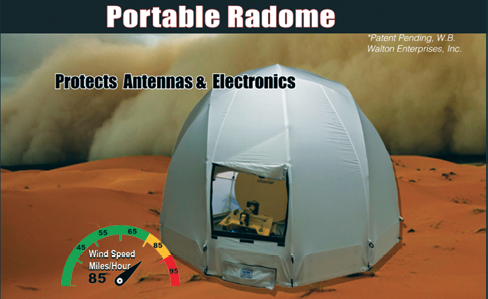Satcoms Innovation Group
The Satcoms Innovation Group (SIG) was established 21 years ago and the organization, at that time, was known as the Satellite Users Interference Reduction Group.
The organization was initiated as the industry had a problem: interference.

At the close of last year, the name was changed to the Satcoms Innovation Group as the remit had moved beyond just interference. The group had always believed the change to SIG as inevitable.
This year has witnessed a big shift of focus for us due to the industry’s change of course and the focus for SIG members is also shifting.
_______________________________
This is an exciting time to be
participants in the satellite
industry. Although challenges
and threats must be faced, the
new opportunities opening
up are endless.
In GEO, we now have a better understanding of the problem — we have good relationships between most operators and the correct tools are now in place to tackle problems as they arise.
This means that interference is being dealt with on a far more immediate basis and, although it still causes the operations teams headaches as they work on resolving issues, they now know how to deal with interference and can often resolve these challenges... almost effortlessly.
What this means is that, in GEO, at least, interference is no longer the most important “I” word.
What has become acutely clear this year is that LEO is now at the identical place GEO was all those years ago. There is a great deal of uncertainty around what problems will be faced.
The LEO constellations have the potential to provide new opportunities for satellite; however, these constellations have the potential to negatively impact the entire space environment and that is clearly something that must be avoided.
Here are the top trends that SIG has witnessed...
1. Focus on Quality of Service
A number of challenges remain for satellite operators in GEO; however, what we have noted this year is a shift in focus from error resolution to improvement in quality of service. That includes ensuring error-free transmission as well as to ensure customers they can be provided with a positive user experience for their services.
Ensuring superb quality is nothing new, but it has never been more important, especially as satellite faces increasing competition from other transmission methods as users also expect flawless delivery of services.

2. Spectrum Battle Continues
The World Radio Conference (WRC-19) is underway at the time of this writing. That always brings up the matter of spectrum sharing and puts the satellite industry into action to defend vital spectrum. However, sharing is inevitable and conversations are moving in that direction. In fact, in Europe, it looks like C-band has been handed over and it may well be that other regions will follow suit.
The broadcast industry faces an interesting quandary. On the one hand, traditional broadcast continues to rely heavily on C-band to deliver services. On the other hand, most broadcasters are under increasing pressure to deliver video everywhere.
As consumers increasingly view video on mobile devices, while simultaneously expecting the same high quality as experienced with other services, those broadcasters are looking to 5G to ensure a solid user experience for their next generation services. That demand will either drive them to look at how spectrum sharing will work, or they will simply move away from satellite for their traditional services.
The author has said it before, and this salient point was made during a presentation delivered on SIG’s behalf by Crystal’s Roger Franklin at NAB this year, but we, the satellite industry, need to look seriously at how spectrum sharing could work without impacting our services.
5G is going to occur, and satellite services could well be negatively impacted.
3. Satellite Starting to Look to the Cloud
SIG is hearing numerous conversations regarding enabling cloud workflows and virtualized ground networks. This topic has come up at all of the SIG events this year and is also a hot topic at most of the industry conferences. With so many new, data-hungry applications scheduled to appear, it is not surprising that turning RF signals into IP has arrived — this means you can send data to the cloud via software modems. This, ultimately, means you can be more flexible, cost effective, able to handle more data and, generally, accomplish far more.
4. Industry Holds its Breath as LEO Launches Ramp Up
LEO launches have dominated the news this year with successful launches and scheduled lift offs. Most recently, SpaceX submitted paperwork for 30,000 more Starlink satellites. That filing, and the recent near collision between ESA and SpaceX satellites, typifies the concerns around LEO. With such a vast number of satellites due to launch, many of which will be introduced by companies that don’t yet have a history in satellite operations, how do we ensure good space (and spectrum) situational awareness (SSA)?
LEO is facing a number of significant challenges, some of which we are acutely aware of , such as the potential of collision, debris and interference.
Other situations we may not yet even be aware of at this time and they might only become clear once those new satellite services have started their maturation process. At SIG’s recent workshop at Work Microwave in Munich, we discussed some of these, including the impact LEO will have on the ground station, something that has had little discussion to date.
These are just some of the reasons that SIG will focus on LEO, the challenges facing those operators, and how we can solve them, at the next SIG workshop. Virtualised ground networks are probably imperative to a concrete solution.
5. The Use of Satellite is Changing but the Opportunities are Endless
This year, the uncertainty for satellite has been increasing as the use case for broadcast is reducing.
Broadcasters are under pressure to deliver more content to more devices than ever before at the same time as they are delivering more engagements and a positive user experience. This means broadcasters are looking to accomplish these tasks as cost-efficiently as possible and are moving toward methods other than satellite to distribute that content, the most notable technology being IP.
Add in the ever-closer rollout of 5G services which will deliver better connectivity than ever before possible, it is no wonder there is concern in the satellite industry. However, what we are starting to see is that satellite will have a different, but equally important, place in the future of communications. More services and higher bandwidth demands means that the industry still needs a way to deliver their services in a timely and reliable fashion.
SIG believes that, rather than looking at 5G and the Internet of Things (IoT) as a threat to satellite, they should be viewed as an opportunity. That being said, this author doesn’t think satellite will be used for consumer applications but rather will be the enabler that makers those technologies function, using all of the layers of connectivity that are available to deliver better infrastructure and connecting 4G and 5G networks together for true, global, cell-to-cell connectivity.
The Year Ahead
This is an exciting time to be participants in the satellite industry. Although challenges and threats must be faced, the new opportunities opening up are endless. What will be important is that we innovate in order to be in the correct position to maximize on those opportunities. As we move into 2020, what this author would like to see is LEO operators gathering around the table with the GEO operators to learn from one another, discuss the challenges, being faced by all and then work together to find solutions for this new satellite industry era.
The Satcoms Innovation Group can be the facilitator of such discussions and certainly encourages this to happen at the SIG workshop in May of 2020, taking place from May 19 to 21, 2020, at historic Goonhilly in the United Kingdom.
satig.space

Martin Coleman is Executive Director, the Satcoms Innovation Group (SIG). Since taking on the position in 2011, Martin has been active in spearheading several significant initiatives, leading the advance in new tools to resolve all types of VSAT interference using SatGuard and the campaign to introduce Carrier ID across all SCPC/MCPC transmissions and subsequent ongoing activities. Martin regularly addresses the industry on the issue of satellite interference and the management of Spectrum and Space, at global industry events and facilitates SIGs workshops throughout the year.
Space Data Association
2019 has been an interesting year when it comes to debris and space situational awareness, key focus areas for the Space Data Association (SDA).

While we have been watching from the wings, the organization has also been busy behind the scenes, determining the future of the group and the role it has to play in the future space environment, which is getting more and more complex to manage.
A 10 Year Anniversary
With so many changes and new challenges currently in the satellite environment, it is interesting to note that 2019 marked 10 years since the infamous collision between a Russian military satellite and an Iridium comms bird. The collision destroyed both spacecraft and caused a cloud of more than 2,000 pieces of debris. While this event was obviously catastrophic for both operators and the entire space environment, it did also bring about a positive change in highlighting the need for better tracking data to ensure this collision wouldn’t be repeated again.
It is not coincidental that 2019 also marked 10 years since the formation of the Space Data Association. Recognizing the need for the industry to do more to protect itself, the major commercial satellite operators decided the best approach would be to work together and share data in order to ensure collisions could be avoided.
The SDA realized even then that the best data to do this was the data from the operators themselves. This is important, not only because we have precise information concerning the location of our fleet, but we also know about planned orbital corrections (so-called maneuvers).
During those ten years much has changed. The Space Data Center continues to provide valuable Collision Avoidance information and is certainly helping to keep space safe. However, at the same time, the space environment is changing and we recognize that there is a need to move with the times to accommodate these crucial changes.
_______________________________
We need the smallsat operators to feed their own data into an independent repository, such as the Space Data Center
A New Challenge in 2019
Over the next few years, we will see the launch of many mega-constellations. This will mean that we will end up with many times the number of satellites on-orbit than today. It is imperative that all space actors, including governments, agencies, operators, and standard setting bodies, up their game to manage the associated risks of having these extra objects in orbit.
The close approach between a European Earth Observation (EO) satellite and SpaceX’s recently launched internet craft and the required evasive maneuver performed by the European Space Agency, which made the top news in 2019, has reminded LEO operators and Space Actors that safety of flight calls for reliable information exchange and close cooperation between all involved in the space environment.
Thankfully, 10 years on, we do have better methods for spotting potential conjunctions, so this potential collision was avoided. Even so, this event again highlights just how important data sharing is to all concerned.
Yet, although members of the SDA account for 273 GEO-stationary satellites, equating to around 6 percent of all active GEO satellites, that is not enough data accumulation to ensure true safety of flight for all satellite operations.

Following the near-miss, the SDA issued a statement urging all space operators to improve operational data sharing and communication to enable effective space situational awareness and maintain the integrity of all orbital regimes.
This is as important in GEO as MEO (Medium Earth Orbit) and LEO (Low Earth Orbit) and needs input from every single operator in any orbital regime.
The Rise of Smallsats
This year has also witnessed a sudden increase in small, LEO satellite launches and announced launches. There are already more than 1,300 active, human-made, satellites in LEO.
Planned launches could see that number rising by ten times that number in just a few years. As mentioned previously, the SDA has already seen the potential damage that could be caused; however, imagine how much more complex tracking all of these will become ans the satellite on-orbit increase in number by the thousands. It simply will not be enough to rely on third party sensor data for this volume of traffic.
We need the smallsat operators to feed their own data into an independent repository, such as the Space Data Center, in order to have accurate, up-to-the-minute and actionable data for all of these elements.
These developments have also shifted the conversation within the SDA. We have been talking about, and responding to the risk of, collision in GEO for some time, and will continue to do so.
Earlier this year, one of the SDA’s Directors, Eutelsat’s David Zamora, presented exactly that at CNES in Paris. However, we now need to also consider these same risks in the other orbital regimes and how those can be best addressed.
To that end, the organization is already in discussions with these operators and are looking to the organisation to understand how these could be best accommodated.
Change Within the SDA
As well as looking at our future services and how those need to be adapted for the future space environment, this year has seen some additional administrative changes.
At the start of November, the SDA chairmanship switched over to Pascal Wauthier to start SES’ stint chairing the organization. As this article’s co-author, Pascal wanted it clarified that Mark has done a sterling job over the past couple of years. This means Pascal has very big boots to fill.
Fortunately, the SDA has an excellent team of Directors to support him and he is certain we will continue with the great work started when Mark was at the helm.
Toward the end of this year, the SDA also accepted on a new member, Viasat. Of course, any membership organization is always pleased to add to its members, but in our case, perhaps even more so. Another member means more data to help make the space environment that much safer and that has to cause for celebration
Also this year, the SDA also held an election for our Standard Member Directors this year. Brian Swinburne of Airbus extend his term and the addition of Lorenzo Arona of Avanti was added to the board. They are both extremely active and welcome additions to the board and are keen to further engagement with the standard members.

Left: Mark Dickinson, SDA
Executive Director Right:
Paul Wauthier, SDA Chairman
and Executive Director
The Road Ahead
Looking forward to 2020, the skies are going to get even more crowded, with many more satellites planned to be put into orbit in the next few years.
Managing potential conjunction events are part of operating in space — this is about how these events are managed, e.g., understanding the data involved to allow an accurate risk assessment to be made and then working with fellow operators to employ coordinated action.
www.space-data.org/sda/
ST Engineering iDirect
In the satellite industry, we have been talking about change for years—about a bold new chapter in our story where innovation will accelerate, and new markets and applications will redefine opportunity.
To prepare for this era, we have seen the launch of ambitious Low Earth Orbit (LEO) constellations, the strategic planning of 5G working groups, the redesign of satellite antennas for a new range of mobility use cases, the consolidation of key industry players and more.
Clearly, we are crossing a divide. In one sense, it’s a divide of scale. Today, we chart opportunity in terms of thousands of network sites and hundreds of megabytes on a remote. We define manageability in terms of provisioning.
 Image collage from ST Engineering iDirect’s participation at the FOKUS FUSECO 5G Forum.
Image collage from ST Engineering iDirect’s participation at the FOKUS FUSECO 5G Forum.
We view interoperability in terms of network management and billing systems. As we shift our attention to future growth plans, we need to think in terms of millions of sites, gigabytes of throughput per remote, true service orchestration within an end-to-end telecom network, service that expands across satellite orbits and access technologies that roam across waveforms and third-party networks.
In another sense, we need to cross over into a new spirit of market readiness. Now is the time to make big moves into the future. Players in the industry must be able to face a larger, more dynamic market with higher stakes. To see a sustainable and substantial return on investment, companies will need to capture revenue quickly and on a larger scale than they have before.
We made our big move this year. In October, ST Engineering officially acquired Newtec and integrated the business with ST Engineering iDirect. With this acquisition, two powerful market leaders have come together to evolve into one dynamic team.
For our customers, this means greater value now and into the future. With our combined strengths, we can better lead our clients and the satellite industry to future market opportunities.
The Evolution of Product and People
Although historically ST Engineering iDirect and Newtec have been competitors, both companies have developed complementary strengths that have evolved from a shared focus on innovation and customers. In particular, ST Engineering iDirect brings together Newtec’s innovations in performance and efficiency with iDirect’s innovations in networking and mobility.
_______________________________
This is an exciting time to be participants in the satellite industry. Although challenges and threats must be faced, the new opportunities opening up are endless.
For our customers, this means access to an expanded product portfolio and to a wealth of expertise. With our combined product solutions, we can build pathways into a broader range of markets than either company could serve on its own.
This new scale will also allow us to dive deeper into current markets — such as aero, cellular backhaul and media — and enable emerging markets and applications, such as land mobility and the Internet of Things (IoT). As a result, we will be able to serve our customers as a single partner that provides technology solutions, market strategy, custom consulting and more.
Of course, none of these achievements would be possible without the right people. Our combined world-class engineering team has the knowledge and skill sets necessary to develop solutions for the future. This will greatly accelerate our time to market so we can keep pace with where new market opportunity is heading.
With our new scale and capabilities, backed by a global, high-touch sales force, we can serve customers no matter what their business model, company size, industry or goals.
We will continue to work closely with customers to help them evolve with the best technology solutions at the right costs, addressing the unique challenges and opportunities emerging in our industry.
Expanding the iQ Series and Driving Customer Growth
This year, we were also busy with other developments that lay the groundwork for industry change.
2019 saw the introduction of Evolution® 4.1.3 software, our go-to release that rounds out the advanced capabilities of our iQ Series remotes through additional features such as 16QAM and AES encryption.
We are achieving the ultimate balance of speed and efficiency to serve markets that demand a cost-effective and high-performance solution.
Building on this momentum, we launched several new remote solutions:
• The iDirect iQ LTE, a software-defined hybrid modem that offers high-efficiency connectivity over satellite or LTE
• The iQ 200 for enterprise and maritime customers
• And the iQ 200 with iDirect SatHaul XE, which provides a cost-effective, high-performance solution for 2G/3G/4G networks within the cellular backhaul market
In 2019, we also expanded our iQ Series on the iDirect Velocity® platform. With the release of iDirect Velocity 2.0, we brought the iQ 200 and iQ LTE, as well as enhanced features such as Layer 2 over Satellite and advanced beam switching, to satellite operators so they can deploy managed services in enterprise, cellular backhaul and maritime markets.
Several of our customers around the world embraced the iQ Series to launch new networks and capture fast-growing opportunities.
• STC Solutions (STCS) adopted the iQ Series this year to launch the first iDirect DVB-S2X network in the Middle East.
• Castor Marine in the Netherlands upgraded its global maritime Ku-band network to support all of its vessels using iDirect iQ 200 remotes.
• Vivacom, the largest telecommunications provider in Bulgaria, also announced it will launch a DVB-S2X maritime service leveraging iQ 200 Series remotes.
• AiTelecom debuted the first iDirect DVB-S2X network in Mexico, using iQ Series remotes across a wide range of enterprise markets.
• IP Access International, which runs the largest satellite network for emergency responders in the U.S., shared plans to integrate the iDirect iQ 200 Board and Evolution 4.1.3 into its HARRIER terminal, a portable and hybrid communications solution for first responders.
A Milestone Year for Newtec
For Newtec, 2019 was a year full of innovation and great success.
In May, Newtec extended its partnership with Marlink to future-proof the company’s global VSAT network through its Newtec Dialog® platform.
Telenor Satellite also expanded its offerings with Newtec to satisfy rising demand from its customers for higher throughput maritime services on its THOR 7 Ka-band High Throughput Satellite with the Newtec Dialog® platform.
At IBC 2019, Newtec teamed up with DVB-I, an initiative to develop technical standards for delivering television services over IP, to showcase the future of universal over-the-top (OTT) television services.
The DVB-I demonstration utilized Newtec’s MCX7000 Multi-Carrier Satellite Gateway as a receiver and revealed the “single hybrid offering” that DVB-I brings. Historically, satellite has been overlooked as an enabler of OTT services, but its synonymity with broadcast and its capability to deliver high-quality, reliable transmissions anywhere makes it ideal to enable universal OTT television services.
Newtec also continued on its mission to connect the unconnected. Newtec deployed a Newtec Dialog® hub for the Bolivian Space Agency (ABE), which will enable the organization to extend access to residential broadband to at least 6,000 users.
Newtec also provided a Newtec Dialog® to SATSOL, a teleport and Internet Service Provider (ISP) on the Solomon Islands, to help connect remote inhabitants.
The platform also was selected by broadband satellite operator Kacific for its new high throughput satellite, Kacific1, to significantly expand broadband service delivery in underserved areas of Southeast Asia, New Zealand and the Pacific Islands.
Newtec was excited to sponsor the Leuven-based Belgian Agoria Solar team this year on their Bridgestone World Solar Challenge, a 3000 km race across Australia powered entirely by the sun. With the help of Newtec and a few other project partners, the team had access to SATCOM-On-The-Move (SOTM) to adjust their navigation and route planning based on the most up-to-date weather patterns.
The team was also able to live stream video interviews and backhaul action video clips to its thousands of followers — sharing every moment of their journey with their online audience.
Driving the Upcoming Era of Innovation
Throughout 2019, both iDirect and Newtec pushed the industry toward a satcom-5G enabled future through involvement with various consortiums and initiatives, with several successful milestone demonstrations providing proof-of-concepts for the integration of satellites into a 5G testbed.
In 2019, ST Engineering iDirect expanded our participation in global initiatives to prove the value that satellite connectivity can bring to a 5G network model.
We teamed up with key SaT5G members at EuCNC 2019 to demo high-speed video streaming over a 5G multi-link satellite and terrestrial network.
At the FOKUS FUSECO Forum, we partnered with key SATis5 members to bring to life Enhanced Mobile Broadband (eMBB) and
IoT applications.
Meanwhile, Newtec played a key role in the world’s first demonstration of 5G backhaul over a LEO satellite with global satellite operator, Telesat, Vodafone and the University of Surrey.
Heading into 2020
At ST Engineering iDirect, we are crossing into 2020 ready to take our customers further into the future.
We will set our sights on building our expanded areas of expertise into a converged technology offering to amplify opportunity in our customers’ core markets and to enable new applications with a focus on mobility, global defense, IoT and smart nations.
2019 was truly a remarkable year, and each member of our newly expanded team is brimming with focused energy and a deeper commitment to our ambitious customers.
Our goal is to create the world’s most advanced satellite ground infrastructure — uniting our technology heritage and passion for innovation — to deliver far more than the company could previously ever have considered possible.
www.idirect.net
W.B. Walton Enterprises
2019 has been an exciting year for Walton De-Ice, (W.B. Walton Enterprises, Inc.) as the company marks 40 years of satellite industry experience helping to protect SATCOMS terminals, gateways and teleports from the effects of weather.

In May, our Chairman, William Bartlett Walton Jr., “Bill Walton” was honored with a Lifetime Achievement Award by the World Teleport Association (WTA) for his leadership and contributions to the industry. In announcing the award, WTA noted that “Today, it is hard to imagine the C-band industry delivering reliable services without de-icing. Walton De-Ice has become synonymous with Earth station antenna De-Icing. Bill Walton was there from the beginning, growing with the industry, and building Walton De-Ice over the last four decades.”
Walton De-Ice delivers the most innovative and effective solutions to help protect critical satellite networks from degradation and outages due to weather. The company’s main focus has been keeping Earth station antennas snow and ice-free. The original Walton Hot-Air (Plenum) De-Ice design mounts behind antennas from 3.7 to 32 meters. Walton De-Ice’s energy-saving Snow Shield, Rain Quake, and Ice Quake systems for 0.6 to 6.3 meter antennas,
Ka-Band Market Leadership and Growth
Market demand from continued HTS and mobility growth has helped to grow the company’s 2019 business from satellite operators, service providers and integrators this past year as they continue to invest in new Ka-band ground infrastructure. In 2019, we continued to expand Ka-band leadership in the De-Icing field, with many hundreds of Ka-band large antenna systems now successfully deployed. For Earth station antennas from 3.7 to as large as 32 meters, the Walton Plenum Hot Air De-Icing system maximizes pointing accuracy that is so critical for protecting Ka-Band services.
Unlike competing anti-icing solutions, such as electric pad systems that can cause reflector distortion, Walton Hot Air De-Ice systems heat the entire antenna reflector uniformly, which minimizes reflector distortion that can cause signal problems at the Ku- and Ka-bands. Walton systems also uniquely offer maximum flexibility with electric, natural gas and liquid propane gas heater options. Infrared testing of optimal antenna heating distribution offers precision performance validation for the most demanding Ka-Band customer applications
C-/Ku-Band De-Icing, More Automation, Energy Efficiency in Heating
Customers with C and Ku-band traditional services continued to leverage the firm’s new automation and control features, along with the Ice Quake system, a super-low energy consumption solution for shedding snow off antennas from 0.6 to 6.3 meters.
The Ice Quake can deliver up to 100X energy-savings compared to traditional anti-icing solutions, which is why it has been adopted in teleports as well as cable and broadcast facilities.
In the third quarter of 2019, we also announced that a global sports TV leader had tapped Walton De-Ice to protect its satellite broadcast facilities, joining a Walton De-Ice user community of top operators in SATCOMs around the world.
_______________________________
Walton De-Ice delivers the
most innovative and effective
solutions to help protect critical
satellite networks from degradation
and outages due to weather.
The top global sports media company added Walton’s Hot Air De-Ice and Snow Shield systems to maximize uptime for critical satellite signals at major TV broadcast centers.
Portable Radome in Remote Broadcast Markets
In September at the IBC 2019 media technology exhibition, Walton showcased the Portable Radome for protecting remote broadcast and sports uplinking applications in extreme weather.
Whether it is for snow at a Winter Olympics, burning sun and dust storms at a Dakar Rally, or heavy winds at a football venue, the Portable Radome protects both on-air signals and satellite equipment from damage.
New LEO/MEO Design Introduced
In Q3, Walton announced its re-designed Portable Radome for Low Earth Orbit and Medium Earth Orbit (LEO/MEO) satellite Earth station applications, enabling expanded full satellite-arc line-of-sight protection for ground antennas such as LEO gateways and MEO terminals that take advantage of low-latency, high-throughput and next-gen satellite constellations.
The Portable Radome can also be used for fixed site ground networks, and deliver gateway site cost-savings and other advantages
New Markets: The Portable Radome
Traditional antenna radomes are not built for transportable operation, yet many of today’s military and first-responder applications on land require deployable systems where harsh elements demand radome-like protection.

Enter the world’s first portable satellite Earth station antenna radome, the Walton Portable Radome, which unleashes a whole new set of possibilities for operating Satellite Transportable Terminals (STT) and micro-VSATs in extreme and mobile conditions to support military requirements for high capacity data, voice and video capabilities worldwide.
It provides a uniquely deployable weather protection solution for applications, such as Military vehicular mount terminals, Comms-On-the-Pause (COTP) or Comms-On-The-Halt (COTH) terminals, VSATs, Transportable uplinks as well as some Enterprise terminals LEO/MEO gateways.
The Walton Portable Radome can protect transportable, trailer and flyaway antennas from high winds, sandstorms, intense heat, snow and ice. Lightweight and airline-shippable for rapid deployment, with easy setup in less than an hour by one person, the Portable Radome goes where no radome has gone before to help live broadcast remotes stay on air.
Complementing protection in harsh winters from snow and ice that the product offers, in burning desert sun heat conditions, an efficient forced air/HVAC system can be added to protect RF and electronics equipment underneath the Radome from overheating damage.
Portable Radome Traction in Government and Defense Markets
In May, the company announced shipments of the Portable Radome product for U.S. Government and European Defense agency projects. Units were sold for deployment with a U.S. Government agency and a European defense agency in separate customer projects.
We noted then that growing numbers of large government and military contractor customers acknowledged the unique advantages that the Portable Radome can enable for their end-customer’s applications around the world.
Looking Ahead
Looking to 2020, the company is very excited about opportunities to work with existing and new industry customers, partners, operators and integrators to help deliver the benefits of the firm’s latest technologies into LEO/MEO/GEO infrastructure, DoD programs, 5G Earth station systems, and other missions.
www.de-ice.com
David Walton is Vice President of Walton De-Ice (W.B. Walton Enterprises, Inc.), where he is responsible for the Snow Shield, Ice Quake products and new product development. He has over 37 years of satellite industry experience in the design, manufacture, and deployment of earth station technology, and holds several patents for his inventions in this field. He can be contacted at: david@de-ice.com, or visit.

